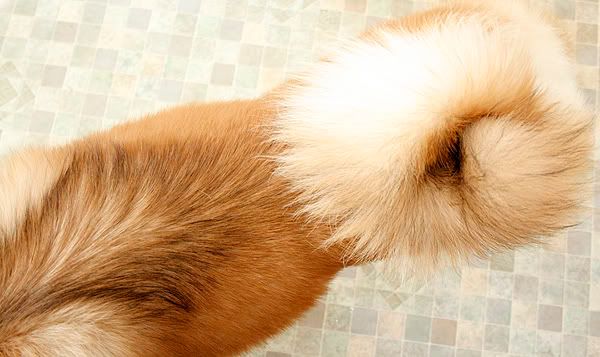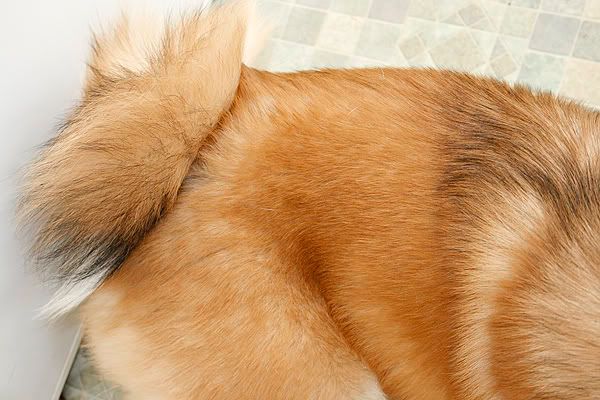How many black tipped hairs make a sesame?!
Just wondering if anyone knows what makes a dog a sesame? Most red Akita Inu I've met have had a few black tipped hairs, I have also seen a few sesames at shows, but I am not sure whether Ayame is going to be considered a sesame or a red.
She has a diamond shape of black tipped hairs across her shoulders and also on her tail, is it enough to be considered sesame or is she a red with a few extra black tipped hairs?!
It doesn't show too well in photos, it's more noticable in RL but here's what I mean...


She has a diamond shape of black tipped hairs across her shoulders and also on her tail, is it enough to be considered sesame or is she a red with a few extra black tipped hairs?!
It doesn't show too well in photos, it's more noticable in RL but here's what I mean...




Comments
I saw a dog last year that was shown as a sesame with a very clear saddle pattern and no black hairs anywhere else, so maybe he was a red too!
A "correct" sesame is very rare. You should she an even spacing of black throughout the coat. Most seen at shows are not correct. I would guess from the picture that your dog is genetically a sesame, but would be considered a "dirty" red by some breeders. When I say genetic sesame, that means she carries the gene that makes her a sesame, she could produce sesame's or even black/tans if bred to a sesame or black/tan. For some reason, some genetic sesame look to be true sesame's others look clear red, some can be dirty reds, but all will produce black/tans or sesame's if bred to them. Even though both your dogs parents were reds there could be a black/tan or sesame as a grandparent or great grand parent, or even further back, which is where the coloring came from.
How old is the dog in the photo? Some get more black as they get older.
Phil
Thank you very much Miss Mallinson, I agree it's very eye catching!
Our Aki started to develop those black tip patterns, both saddle and diamond back patterns. See video
We were just wondering whether it will go away or she will end up having what looks like GSD marking on her back.
http://www.akita.nl/hond.php?id=10&nk=1
actually that akita in the link ,Natsumi Yumenoshima No Go, has both parents registered with AKIHO.
father
Seiryuu Go Ryuuhou Yamagami Akiho 97-3815
http://www.akita.nl/hond.php?id=3
mother
Yachigusa Go Toyama Kensow Akiho 00-144
http://www.akita.nl/hond.php?id=27
MnV - i am willing to be the black tips will go away at one point. Kaeda had similar hair patterns a few months ago. They were grey and not dark but you get the point.
In the JKC (pink) Akita book there is a reference to how fast pinto, sesame, and one other color sort of disappeared as the restoration of the breed progressed. Also (as much as I do not like using this for reference) under the Akiho meeting notes @ northlandakitas: They mentioned that dropping Goma was on the table but was premature at the time. So I feel that sesame is a color of the past with regards to the JA and other than a few reds with some black tips, we will not see sesame like we do in the vintage akita photos.
Hopefully that makes sense
Sesame (black-tipped hairs on a rich red background) with urajiro. Tipping is light and even on the body and head with no concentration of black in any area. Sesame areas appear at least one-half red. Sesame may end in a widow's peak on the forehead, leaving the bridge and sides of the muzzle red. (AKC-Shiba)
We should be able to the JA as well and should note the tips are: "light and even on the body and head with no concentration of black in any area." So in your case and in the case of the one from akita.nl there is a concentration of black tips.
At this point I expect to find a Sesame Japnese Akita someday- Most likely in a field next to a unicorn, santa, and the easter bunny.
http://www.nihonken.org/forum/comments.php?DiscussionID=4716&page=1#Item_48
the pic of akita I'm talking about is near the bottom of the thread.
Well unless there is a mistake - the red with the saddle you listed grew up into a rather light red as an adult.
This is here photo gallery - N.H.S.B. 2405518
http://of-shiroi-na-suna.de/dogs.html
The puppy
The adult
So it stands to reason that these are just darker reds.
Aki's dark marking is very similar to Natsumi. However, she didn't have those darkings as a young puppy at 2 1/2 months old when I first brought her back. It just all of a sudden started showing up.
I'll take a picture and post it. It's basically like the dark patterns you see in her videos.